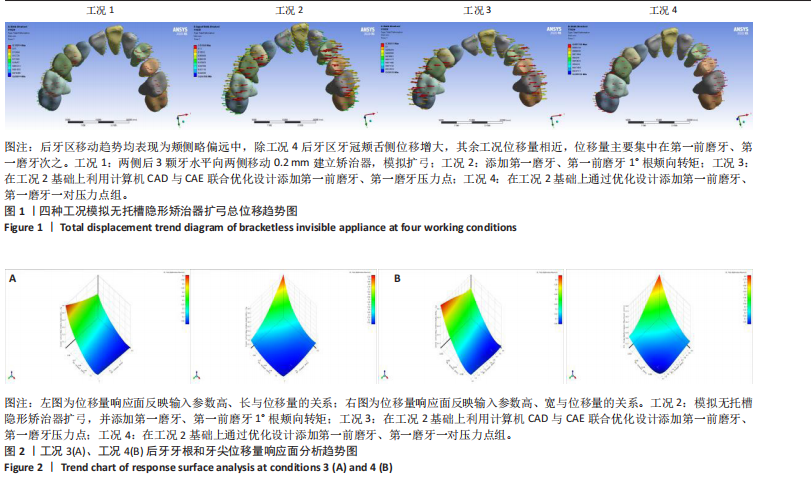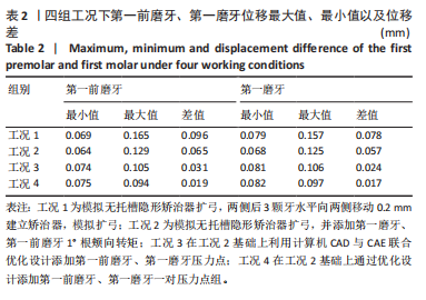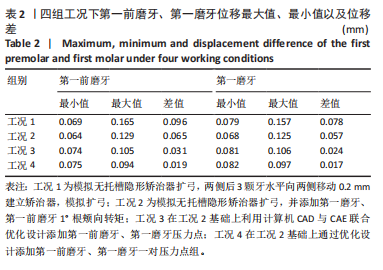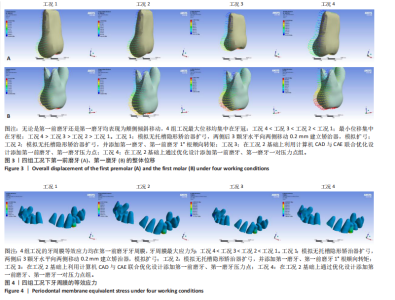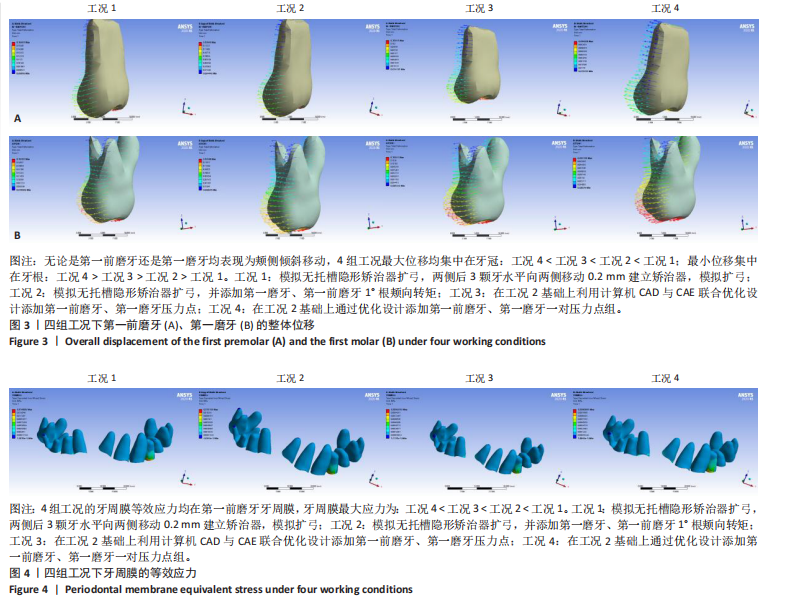Chinese Journal of Tissue Engineering Research ›› 2026, Vol. 30 ›› Issue (11): 2745-2751.doi: 10.12307/2026.075
Previous Articles Next Articles
Optimal finite element analysis of arch expansion in patients with cleft palate with bracketless invisible appliance during dental replacement
Yu Miao1, Shao Tianyang1, Zhuang Yan1, Luan Chunyang1, Zhao Yue2
- 1Jiamusi University School of Stomatology, Key Laboratory of Oral Biomedicine and Clinical Application of Heilongjiang Province, Jiamusi University School of Stomatology Experimental Center for Stomatological Engineering, Jiamusi 154002, Heilongjiang Province, China; 2Department of Pediatric Dentistry, Jiamusi University Affiliated Stomatological Hospital, Jiamusi University School of Stomatology, Jiamusi 154002, Heilongjiang Province, China
-
Received:2024-03-01Accepted:2025-05-16Online:2026-04-18Published:2025-09-05 -
Contact:Zhao Yue, MS, Chief physician, Department of Pediatric Dentistry, Jiamusi University Affiliated Stomatological Hospital, Jiamusi University School of Stomatology, Jiamusi 154002, Heilongjiang Province, China -
About author:Yu Miao, MS candidate, Jiamusi University School of Stomatology, Key Laboratory of Oral Biomedicine and Clinical Application of Heilongjiang Province, Jiamusi University School of Stomatology Experimental Center for Stomatological Engineering, Jiamusi 154002, Heilongjiang Province, China
CLC Number:
Cite this article
Yu Miao, Shao Tianyang, Zhuang Yan, Luan Chunyang, Zhao Yue. Optimal finite element analysis of arch expansion in patients with cleft palate with bracketless invisible appliance during dental replacement[J]. Chinese Journal of Tissue Engineering Research, 2026, 30(11): 2745-2751.
share this article
Add to citation manager EndNote|Reference Manager|ProCite|BibTeX|RefWorks
| [1] CANFIELD MA, HONEIN MA, YUSKIV N, et al. National estimates and race/ethnic-specific variation of selected birth defects in the United States, 1999-2001. Birth Defects Res A Clin Mol Teratol. 2006;76(11):747-756. [2] NAGASE Y, NATSUME N, KATO T, et al. Epidemiological Analysis of Cleft Lip and/or Palate by Cleft Pattern. J Maxillofac Oral Surg. 2010;9(4):389-395. [3] PARK YJ, DERDERIAN C, OPPEDISANO M. Interdisciplinary Approach for the Treatment of Complex Bilateral Cleft Lip and Palate With Missing Premaxilla. Cleft Palate Craniofac J. 2022;59(5):680-687. [4] NASREDDINE G, EL HAJJ J, GHASSIBE-SABBAGH M. Orofacial clefts embryology, classification, epidemiology, and genetics. Mutat Res Rev Mutat Res. 2021; 787:108373. [5] KHDAIRI N, HALILAH T, KHANDAKJI M, et al. Rapid Maxillary Expansion Treatment in Patients with Cleft Lip and Palate: A Survey on Clinical Experience in the European Cleft Centers. J Clin Med. 2023;12(9):3159. [6] BÖLÜKBAŞI E, YILMAZ B, RAMOĞLU Sİ. Stress Distribution and Displacement of Craniofacial Structures Following Rapid Maxillary Expansion in Different Types of Cleft Palate: A Three-Dimensional FEM Study. Turk J Orthod. 2021; 34(2):77-85. [7] HOLBERG C, HOLBERG N, SCHWENZER K, et al. Biomechanical analysis of maxillary expansion in CLP patients. Angle Orthod. 2007;77(2):280-287. [8] PATIÑO AMB, RODRIGUES M DE P, PESSOA RS, et al. Biomechanical behavior of three maxillary expanders in cleft lip and palate: a finite element study. Braz Oral Res. 2024;38:e010. [9] LU L, ZHANG L, LI C, et al. Treatment effects after maxillary expansion using invisalign first system vs. acrylic splint expander in mixed dentition: a prospective cohort study. BMC Oral Health. 2023;23(1):598. [10] SHEN CA, GUO R, LI W. Enamel defects in permanent teeth of patients with cleft lip and palate: a cross-sectional study. J Int Med Res. 2019;47(5):2084-2096. [11] PARDO A, VANTI V, LONARDI F, et al. Oral health in patients with cleft lip and palate: a systematic literature review and meta-analysis of periodontal and dental disease and oral microbiota (part 1). BMC Oral Health. 2025; 25(1):154. [12] CASTROFLORIO T, SEDRAN A, PARRINI S, et al. Predictability of orthodontic tooth movement with aligners: effect of treatment design. Prog Orthod. 2023;24(1):2. [13] MEAZZINI MC, TORTORA C, MAZZOLENI F, et al. Comparison of Pain Perception in Patients Affected by Cleft and Cranio Facial Anomalies Treated With Traditional Fixed Appliances or Invisalign. Cleft Palate Craniofac J. 2020;57(1):35-42. [14] TORTORA C, POLI C, SURIANO A, et al. Cross-sectional evaluation of periodontal inflammation and oral hygiene status between fixed appliances and Invisalign in patients affected by craniofacial anomalies. Int J Dent Hyg. 2023;21(2):328-333. [15] KIM JE, KIM S, KIM DH. Comparison of oral health status, oral hygiene management behaviours and satisfaction of patients with fixed orthodontic appliance and clear aligner: A quasi-experimental design. Int J Dent Hyg. 2024;22(4):939-948. [16] MA S, WANG Y. Clinical outcomes of arch expansion with Invisalign: a systematic review. BMC Oral Health. 2023;23(1):587. [17] ZHOU N, GUO J. Efficiency of upper arch expansion with the Invisalign system. Angle Orthod. 2020;90(1):23-30. [18] MERT S, MALYARAN H, CRAVEIRO RB, et al. Comparative analysis of proliferative and multilineage differentiation potential of human periodontal ligament stem cells from maxillary and mandibular molars. J Periodontol. 2023;94(7):882-895. [19] DEDERICHS M, JOEDECKE P, WEBER CT, et al. Functional Load Capacity of Teeth with Reduced Periodontal Support: A Finite Element Analysis. Bioengineering (Basel). 2023;10(11):1330. [20] WANG Y, DARAQEL B, WANG Y, et al.Biomechanical effects of different mandibular movements and torque compensations during mandibular advancement with clear aligners: a finite element analysis. Front Bioeng Biotechnol. 2024;12:1496517. [21] JIA L, WANG C, LI L, et al. The effects of lingual buttons, precision cuts, and patient-specific attachments during maxillary molar distalization with clear aligners: Comparison of finite element analysis. Am J Orthod Dentofacial Orthop. 2023;163(1):e1-e12. [22] LI N, WANG CJ, WANG Y, et al.Three-dimensional finite element analysis of retracting pathological migration of the right upper central incisor with a clear aligner. Comput Methods Biomech Biomed Engin. 2024;27(16):2325-2332. [23] LI N, WANG C, YANG M, et al. Effects of different tooth movement patterns and aligner thicknesses on maxillary arch expansion with clear aligners: a three-dimensional finite element study. Front Bioeng Biotechnol. 2024; 12:1424319. [24] KARSLI N, OCAK I, AKYILDIZ M, et al. Evaluation of the effect of different attachment configurations on molar teeth in maxillary expansion with clear aligners - a finite element analysis. BMC Oral Health. 2024;24(1):921. [25] TOMS SR, EBERHARDT AW. A nonlinear finite element analysis of the periodontal ligament under orthodontic tooth loading. Am J Orthod Dentofacial Orthop. 2003;123(6):657-665. [26] KORU AKAN BE, HANCIOĞLU KIRCELLI B, PAŞAOĞLU BOZKURT A, et al. A finite element analysis of the effects of semipontic design on tooth movement during mesialization of the mandibular second molar with clear aligners. Am J Orthod Dentofacial Orthop. 2024;166(5):490-502. [27] MORAVEDJE TORBATY P, SUH H, TAI SK, et al. Vertical and transverse treatment effects of Invisalign First system compared to Hyrax maxillary expanders with fixed appliances in mixed dentition patients. Angle Orthod. 2024;94(5):496-503. [28] PEDE K, SHETTY P, RANJAN A, et al. Evaluation of effects of different sizes and shapes of attachments during rotation, tipping, and torquing in clear aligner therapy - A finite element study. J Orthod Sci. 2024;13:30. [29] AHMAD W, JIANG F, XIONG J,et al.The mechanical effect of geometric design of attachments in invisible orthodontics. Am J Orthod Dentofacial Orthop. 2023;164(2):183-193. [30] 王海秀. 基于ANSYS天然气水合物反应釜的有限元分析和优化设计[J].广东石油化工学院学报,2011,21(3):18-20. [31] 周磊, 戴瑜龙, 曾敏. 基于UG/ANSYS的液压挖掘机动臂结构优化设计[J].机电信息,2024(22):42-46. [32] LEVRINI L, CARGANICO A, ABBATE L. Maxillary expansion with clear aligners in the mixed dentition: A preliminary study with Invisalign® First system.Eur J Paediatr Dent. 2021;22(2):125-128. [33] ROBERTSON L, KAUR H, FAGUNDES N C F, et al. Effectiveness of clear aligner therapy for orthodontic treatment: A systematic review. Orthod Craniofac Res. 2020;23(2):133-142. [34] 吴越琳, 刘加荣. 三维有限元分析在口腔医学领域的研究进展[J].口腔医学,2021,41(7):659-663. [35] 孙永刚, 雷刚. 基于结构优化理论的现代CAE技术[J]. 重庆工学院学报(自然科学版),2007,21(9):77-82+95. [36] PAPADOPOULOS MA, KOUMPRIDOU EN, VAKALIS ML, et al. Effectiveness of pre-surgical infant orthopedic treatment for cleft lip and palate patients: a systematic review and meta-analysis. Orthod Craniofac Res. 2012;15(4): 207-236. [37] 王丽卡苏世沛. 腭裂修复术后并发症的预防体会[J]. 山东医药, 2005(14):46. [38] YAO J F, DENG M Z, XIE T, et al. Study on the application of oral digital design in aesthetic restoration of anterior teeth of cleft lip/palate patients. Hua Xi Kou Qiang Yi Xue Za Zhi. 2021;39(5):582-590. [39] LEE H, NGUYEN A, HONG C, et al. Biomechanical effects of maxillary expansion on a patient with cleft palate: A finite element analysis. Am J Orthod Dentofacial Orthop. 2016;150(2):313-323. [40] LI N, WANG C, YANG M, et al. Effects of different tooth movement patterns and aligner thicknesses on maxillary arch expansion with clear aligners: a three-dimensional finite element study. Front Bioeng Biotechnol. 2024; 12:1424319. [41] SIMON M, KEILIG L, SCHWARZE J, et al.Treatment outcome and efficacy of an aligner technique--regarding incisor torque, premolar derotation and molar distalization. BMC Oral Health. 2014;14:68. [42] KAUR H, OWEN B, TRAN B, et al. The biomechanics of posterior maxillary arch expansion using fixed labial and lingual appliances. Angle Orthod. 2020;90(5):688-694. [43] 陈文儿, 钱玉芬. 无托槽隐形矫治技术中附件应用及进展[J].中国实用口腔科杂志,2018,11(10):628-632. [44] KRAVITZ ND, KUSNOTO B, BEGOLE E, et al.How well does Invisalign work? A prospective clinical study evaluating the efficacy of tooth movement with Invisalign. Am J Orthod Dentofacial Orthop. 2009;135(1):27-35. [45] NUCERA R, DOLCI C, BELLOCCHIO AM, et al. Effects of Composite Attachments on Orthodontic Clear Aligners Therapy: A Systematic Review. Materials (Basel). 2022;15(2):533. [46] LIU L, ZHAN Q, ZHOU J, et al. Effectiveness of an anterior mini-screw in achieving incisor intrusion and palatal root torque for anterior retraction with clear aligners. Angle Orthod. 2021;91(6):794-803. [47] 王江婷, 陈梅, 张瑞晶, 等. 无托槽隐形矫治器腭侧边缘不同延伸长度在拔牙病例中力学特点的三维有限元分析[J]口腔医学研究,2024, 40(11):960-966. [48] WEHBY GL, CASSELL CH. The impact of orofacial clefts on quality of life and healthcare use and costs. Oral Dis. 2010;16(1):3-10. [49] MEAZZINI MC, DEMONTE LP, COHEN N, et al. The Use of Clear Aligners in Multi-Segmental Maxillary Surgery: A Case-Control Study in Cleft Lip and Palate and Skeletal Class III Patients. J Clin Med. 2024;13(5):1329. [50] MEAZZINI MC, DEMONTE LP, AUTELITANO L. Segmental maxillary osteotomy in cleft lip and palate patients: a stepwise planning in the orthodontic pre-surgical preparation with Invisalign. Eur J Paediatr Dent. 2024;25(3):224-229. |
| [1] | Liu Wenlong, Dong Lei, Xiao Zhengzheng, Nie Yu. Finite element analysis of tibial prosthesis loosening after fixed-bearing unicompartmental knee arthroplasty for osteoporosis [J]. Chinese Journal of Tissue Engineering Research, 2026, 30(9): 2191-2198. |
| [2] | Zheng Wangyang, Fei Ji, Yang Di, Zhao Lang, Wang Lingli, Liu Peng, Li Haiyang. Finite element analysis of the force changes of the supraspinatus tendon and glenohumeral joint during the abduction and flexion of the humerus [J]. Chinese Journal of Tissue Engineering Research, 2026, 30(9): 2199-2207. |
| [3] | Cai Qirui, Dai Xiaowei, Zheng Xiaobin, Jian Sili, Lu Shaoping, Liu Texi, Liu Guoke, Lin Yuanfang. Mechanical effects of Long’s traction orthopedic method on cervical functional units: quantitative analysis of biomechanical model of head and neck [J]. Chinese Journal of Tissue Engineering Research, 2026, 30(9): 2208-2216. |
| [4] | Rao Jingcheng, Li Yuwan, Zheng Hongbing, Xu Zhi, Zhu Aixiang, Shi Ce, Wang Bing, Yang Chun, Kong Xiangru, Zhu Dawei. Biomechanical differences between the new proximal femoral stable intramedullary nail and traditional intramedullary nail#br# [J]. Chinese Journal of Tissue Engineering Research, 2026, 30(9): 2217-2225. |
| [5] | Chen Long, Wang Xiaozhen, Xi Jintao, Lu Qilin. Biomechanical performance of short-segment screw fixation combined with expandable polyetheretherketone vertebral body replacement in osteoporotic vertebrae [J]. Chinese Journal of Tissue Engineering Research, 2026, 30(9): 2226-2235. |
| [6] | Chen Huiting, Zeng Weiquan, Zhou Jianhong, Wang Jie, Zhuang Congying, Chen Peiyou, Liang Zeqian, Deng Weiming. Tail anchoring technique of vertebroplasty in treatment of osteoporotic vertebral compression fractures with intravertebral cleft: a finite element analysis [J]. Chinese Journal of Tissue Engineering Research, 2026, 30(9): 2145-2152. |
| [7] | Cheng Qisheng, Julaiti·Maitirouzi, Xiao Yang, Zhang Chenwei, Paerhati·Rexiti. Finite element analysis of novel variable-diameter screws in modified cortical bone trajectory of lumbar vertebrae [J]. Chinese Journal of Tissue Engineering Research, 2026, 30(9): 2162-2171. |
| [8] | Liu Jiafu, Ren Ruxia, Liao Zhouwei, Zhou Xiali, Wu Yihong, Zhang Shaoqun. Three-dimensional finite element analysis of cervical spine biomechanical characteristics in a rat model of cervical vertigo [J]. Chinese Journal of Tissue Engineering Research, 2026, 30(9): 2182-2190. |
| [9] | Zheng Xuying, Hu Hongcheng, Xu Libing, Han Jianmin, Di Ping. Stress magnitude and distribution in two-piece cement-retained zirconia implants under different loading conditions and with varying internal connection shapes [J]. Chinese Journal of Tissue Engineering Research, 2026, 30(8): 1979-1987. |
| [10] | Fan Yongjing, Jin Wulong, Bai Haoyu, Ma Ping, Wang Shu. Role and mechanism of stem cells from human exfoliated deciduous teeth in tissue regeneration and disease treatment [J]. Chinese Journal of Tissue Engineering Research, 2026, 30(7): 1850-1857. |
| [11] | Zhong Caihong, Xiao Xiaoge, Li Ming, Lin Jianhong, Hong Jing. Biomechanical mechanism of sports-related patellar tendinitis [J]. Chinese Journal of Tissue Engineering Research, 2026, 30(6): 1417-1423. |
| [12] | Xu Hao, Ding Lu, Li Xiao. Mechanical effect of mechanical wear of abutment screws on the Morse taper connection implant system: a three-dimensional finite element analysis [J]. Chinese Journal of Tissue Engineering Research, 2026, 30(6): 1375-1383. |
| [13] | Yan Chengbo, Luo Qiuchi, Fan Jiabing, Gu Yeting, Deng Qian, Zhang Junmei. Effect of type 2 diabetes mellitus on orthodontic tooth movement and bone microstructure parameters on the tension side in rats [J]. Chinese Journal of Tissue Engineering Research, 2026, 30(4): 824-831. |
| [14] | Yu Xinlin, Chen Huiyu, Wang Yingying, Guo Weizhong, Feng Bin Lin Chengshou, Lin Wang. Finite element analysis of internal fixation with new retrograde intramedullary nail on lateral femur condyle for distal type A2 femur fractures [J]. Chinese Journal of Tissue Engineering Research, 2026, 30(3): 546-552. |
| [15] | Zhao Jingang, Liu Liping, Chen Jianwei, . Finite element analysis comparing lumbar fusion and artificial intervertebral disc replacement [J]. Chinese Journal of Tissue Engineering Research, 2026, 30(3): 553-560. |
| Viewed | ||||||
|
Full text |
|
|||||
|
Abstract |
|
|||||

